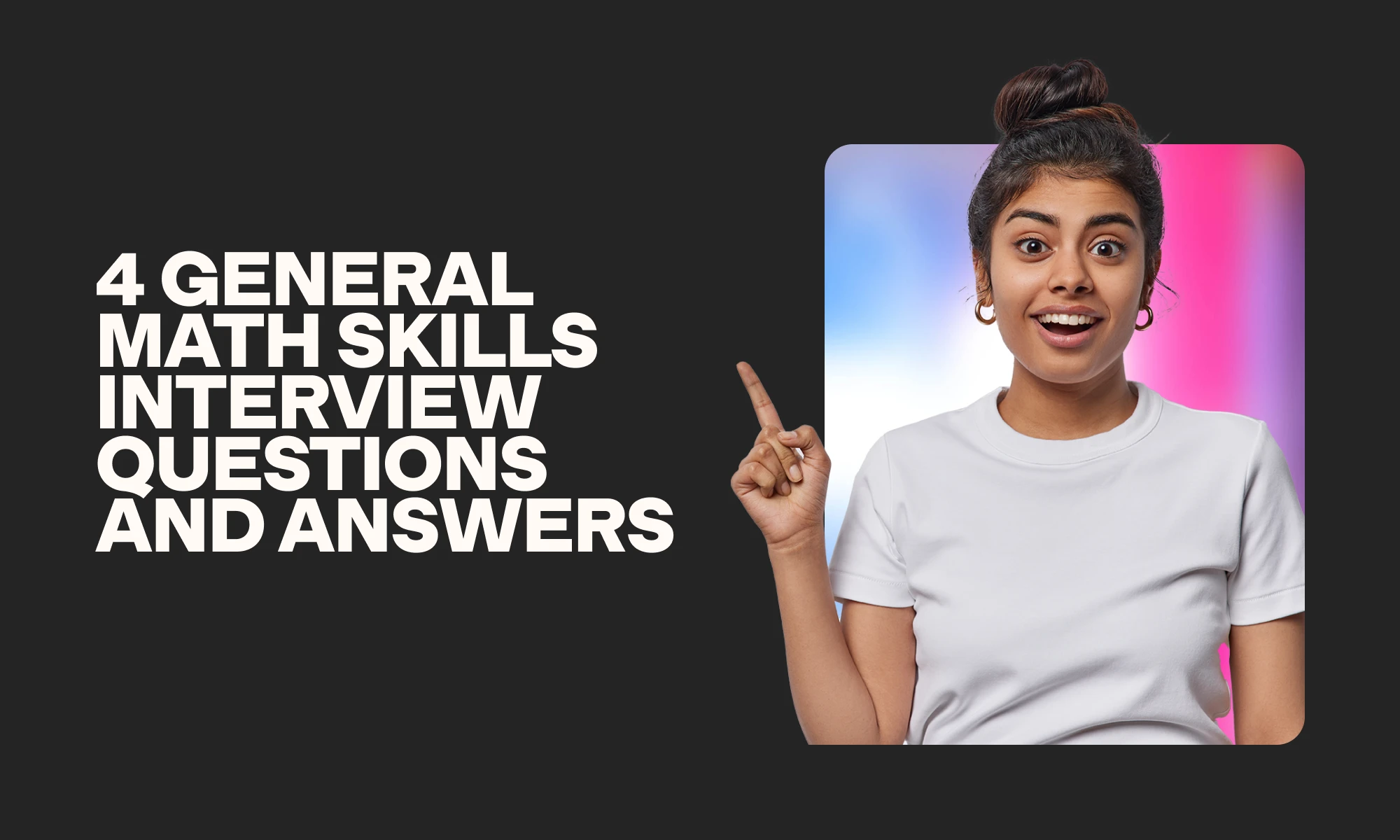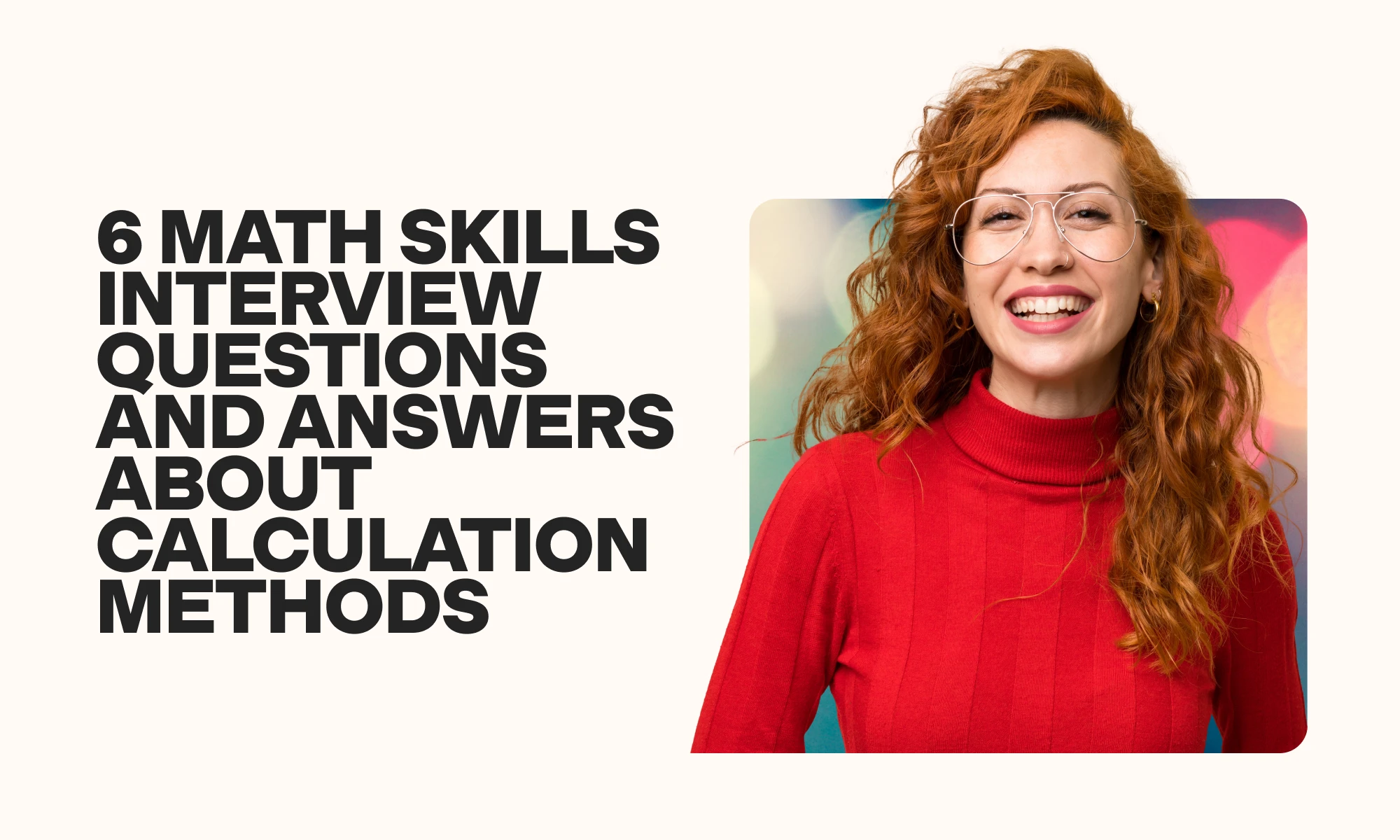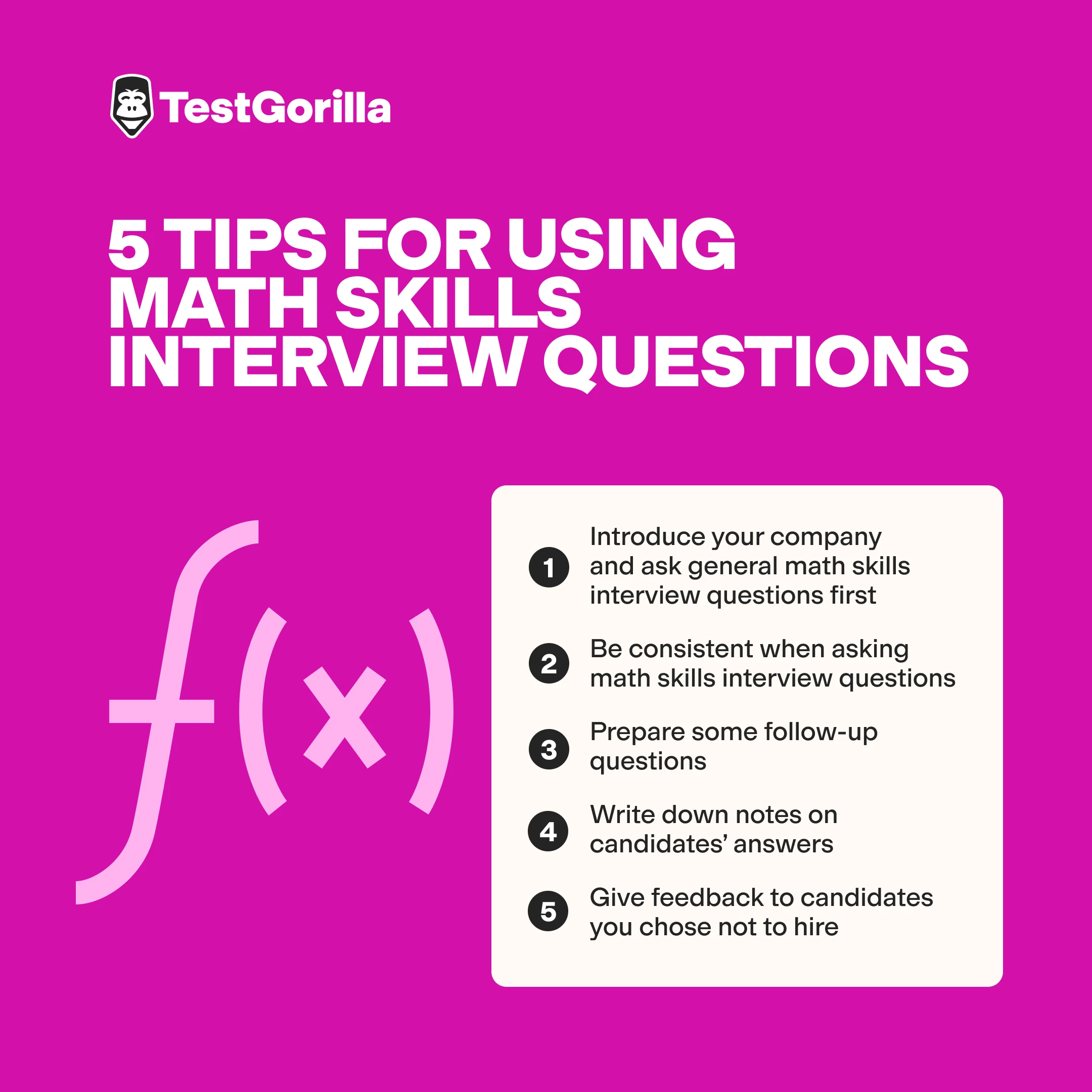Hire skilled professionals with talent assessments by TestGorilla
It’s critical to find candidates with math skills when recruiting for finance, technology, and engineering roles.
Employees’ math skills can make or break a business, so you should know how to accurately assess your applicants’ math skills when you’re hiring skilled professionals.
Although this isn’t simple, there are some effective methods you can use to assess them.
You might already know that interviewing candidates is essential for evaluating their math skills.
But have you heard of skills assessments, and do you have the right math skills interview questions for your hiring process?
Our list of math skills interview questions below can help you choose your own questions. You’ll also want to stick around for our advice on using skills assessments to hire skilled professionals.
Table of contents
- 4 general math skills interview questions and answers
- 15 math skills interview questions and answers about mathematical definitions
- 6 math skills interview questions and answers about calculation methods
- For which roles should you use math skills interview questions?
- When should you use math skills interview questions?
- 5 tips for using math skills interview questions
- Hire a skilled professional with comprehensive math skills interview questions
4 general math skills interview questions and answers
Use these four general math skills interview questions to assess your candidates’ experience, math skills, and methods for working with numbers.
1. How do you improve your math skills?
Are your candidates constantly improving their math skills? Ask them how they do so.
Candidates may respond that they continuously use mathematics as part of their current job. They may also mention some other methods or hobbies that help them enhance their skills, such as completing quizzes regularly.
2. What are your strongest math skills, and how do you use them during work?
Your candidates’ responses to this question may vary. For example, whereas one candidate may have strong arithmetic skills, another may have exceptional calculus skills. When you ask this question, it’s vital to look for evidence that shows how strong their skills are.
For example, a candidate with excellent arithmetic skills may use them to count back change at work, and a candidate with great algebra skills may use them to calculate an unknown variable in an accounting equation.
3. Describe your work-related math experience.
This question can help you learn if your candidates’ math experience matches your open role. If you’re looking for an accountant who can calculate compound interest, consider candidates who have skills in this area. If you’re hiring for a cashier position, look for candidates with simple arithmetic skills.
If your candidates haven’t recently used the skills you’re looking for, find out how they would improve the skills required for the vacancy.
4. Which skills or methods do you use to perform accurate mathematical calculations?
Candidates may list several skills they use to perform mathematical calculations accurately. They may explain that they pay close attention to detail or check their calculations two or three times to ensure they have used the right formula.
Your candidates may also mention that they use software to double-check their calculations and verify they are correct.
15 math skills interview questions and answers about mathematical definitions
Here are 15 math skills interview questions related to mathematical definitions. Ask your candidates these questions to evaluate their mathematical knowledge.
1. What is a linear equation?
Are your candidates aware they can use linear equations to solve a calculation related to distance, time, and speed or to weight, mass, and density? The best candidates will be able to give an example of a linear equation or the structure it uses (for example, Ax + Zy = C).
2. Explain what plane geometry is.
Plane geometry is a branch of mathematics that deals with flat, two-dimensional shapes. Candidates should know that in plane geometry, flat shapes like triangles or circles are placed on a two-dimensional plane.
3. Explain what solid geometry is.
Solid geometry is a branch of mathematics related to three-dimensional objects, including spheres, cylinders, and cubes. When answering this question, candidates may compare plane geometry with solid geometry or solid objects with shapes.
4. What does “percentage” mean? Give an example of how percentages are essential.
Candidates should be aware that percentages are numbers that represent a fraction of 100. They may say that percentages are essential for market research calculations, interest rates, shop discounts, and inflation rates.
5. Explain what “mean” refers to in mathematics.
The mean refers to the average value of a set of numbers. For example, the mean value of the numbers two, three, and four is three.
6. Explain what algebra is.
Can your candidates explain that algebra is a branch of mathematics in which letters and symbols represent numbers or objects to reflect their relationship?
Candidates may mention some ways that algebra can be used in the workplace to calculate an unknown variable. For example, if a cashier sold five chocolates and has two left, they can calculate the original number of chocolates they had using algebra.
7. Explain what the commutative laws are.
Candidates should understand that according to the commutative laws, you can rearrange numbers in an equation and still end up with the same sum or product. One example of this is the equation a + z = z + a.
8. Explain what the associative laws are.
Candidates should know that the associative laws state that when you add or multiply three real numbers, the grouping of those numbers doesn’t affect the resulting value. An example of the associative laws in an equation is (x + y) + z = (x + y) + z.
9. Explain what the distributive laws are.
Can your candidates explain that according to the distributive laws, the result of an equation will be the same whether you multiply the numbers in the equation added together or multiply the numbers separately and add them together?
10. Explain what BODMAS means.
How familiar are your candidates with the acronym BODMAS? Do they know that they can use it to solve complex calculations? Candidates may explain that each letter in BODMAS has a meaning:
Brackets
Orders (which refers to square roots and powers)
Division
Multiplication
Addition
Subtraction
They should be able to explain that they would follow the order indicated by BODMAS to solve an equation and that they can even use it to solve complex problems.
11. What is a tangent?
A tangent is a line on a graph that touches a curve but does not divide, pass through, or cut the curve.
12. What is the standard deviation?
The standard deviation refers to the measure of how spread out data is relative to its mean value. Candidates may mention that the standard deviation is represented by the Greek letter sigma (σ).
13. Explain what a cubic meter is.
A cubic meter is a unit of measurement that mathematicians use to determine an object’s volume based on its length, width, and height. Candidates should understand that cubic meters are represented by the unit “m” to the power of three and may explain that one cubic meter is the equivalent of 1000 liters.
14. Explain what calculus is.
Calculus refers to a branch of math that involves finding the different properties of integrals and derivatives of functions. There are two main types of calculus: integral calculus and differential calculus.
Differential calculus analyzes how quickly different factors change as represented on the slope of a tangent. In contrast, integral calculus focuses on the sizes or values of different factors and deals with volume or area.
15. Explain what an exterior angle is in a polygon.
Candidates should know that an exterior angle is an angle between one side of a polygon and a line that extends from the next side. They may explain that they would calculate an exterior angle of a regular polygon by using the following formula:
Exterior angle = 360 / number of sides
The best insights on HR and recruitment, delivered to your inbox.
Biweekly updates. No spam. Unsubscribe any time.
6 math skills interview questions and answers about calculation methods
How well can your candidates carry out fundamental calculations? Use the six math skills interview questions in this section to find out.
1. How do you calculate simple interest?
Candidates may explain that you can calculate simple interest by multiplying the percentage of the principal amount of money by the daily interest rate and the total number of days that pass from payment to payment.
2. Explain how to calculate the mean of a set of numbers.
You can calculate the mean of a set of numbers by adding together every number value in the set and dividing the sum by the total number of values in the set. For example, to calculate the mean of the numbers five, six, seven, eight, and nine, you would add all of these numbers together and divide the result by five since there is a total of five numbers in the set.
3. How do you convert fractions to percentages?
Converting fractions to percentages is as simple as dividing the top number of the fraction (the numerator) by the bottom number of the fraction (the denominator) and then multiplying the value by 100.
For example, to convert 2/5 into a percentage, divide two by five, and multiply the result by 100 to get 40%.
4. How do you convert percentages into fractions?
To convert a percentage into a fraction, write a fraction with the percentage value as the numerator and 100 as the denominator. Then, divide the numerator and denominator by their greatest common factor to reduce the fraction to its lowest terms.
For example, to convert 40% into a fraction, place 40 over 100. Then, divide the numerator and denominator by their greatest common factor, 20. This results in the fraction 2/5.
5. Explain how to calculate the value saved due to a discount.
To find the amount a customer has saved because of a discount, divide the initial value by 100 to get 1% of the original value. Multiply the result by the discount percentage.
For example, if the initial price of a customer’s groceries was $60, and they receive a discount of 5%, find 5% of $60, which is $3.
6. Explain how a line, plane, solid, and point are different.
The factor that makes lines, planes, solids, and points different is their dimensions. Points have no dimensions, lines are one-dimensional, planes are two-dimensional, and solids are three-dimensional.
For which roles should you use math skills interview questions?
Some of the roles you can use math skill interview questions for include accounting positions, bank teller roles, engineering jobs, computer programmer roles, software engineering jobs, medical professional positions, auditor roles, and business intelligence analyst jobs.
If you work for an enterprise that relies on its employees’ mathematical skills, you should use math skills interview questions to assess applicants during the hiring process.
When should you use math skills interview questions?
Since performing skills testing first can make your hiring process more manageable, always give candidates skills assessments at the earliest opportunity and then conduct interviews afterward.
You should use pre-employment math tests before asking math skills interview questions to ensure every candidate you interview has the right skills for the job.
Hire a candidate with the right math skills
Are you ready to hire a candidate with the right math skills using our talent assessments?
5 tips for using math skills interview questions
For a more straightforward hiring process, use the five tips in this section when asking candidates math skills interview questions.
1. Introduce your company and ask general math skills interview questions first
Begin the interview by talking about your company and asking general math skills interview questions to learn about your candidate’s general experience.
2. Be consistent when asking math skills interview questions
Try to ask the questions in the same order for each candidate. This ensures the hiring process is consistent and that all candidates are assessed fairly.
3. Prepare some follow-up questions
Since some candidates may provide limited responses, be prepared to ask follow-up questions to better understand their math experience and skills. For example, if candidates tell you that simple arithmetic is their strongest math skill, find out more by asking why it’s important in their current role.
4. Write down notes on candidates’ answers
Note-taking can help you make comparisons between candidates. Always tell candidates that you will be writing notes as part of the interview process, especially if you’re conducting a video interview.
5. Give feedback to candidates you chose not to hire
Providing accurate feedback to candidates you decided not to hire can improve the candidate experience. Use skills tests to help with this, and explain why you didn’t choose them.
Hire a skilled professional with comprehensive math skills interview questions
The most efficient way to hire a professional with the math skills you’re looking for is using math skills interview questions and skills testing, so choose from our questions and check out our test library to start making your assessment.
TestGorilla is here to simplify your hiring process. Choose us to hire a professional, skilled employee for your enterprise. Get started for free today.
You've scrolled this far
Why not try TestGorilla for free, and see what happens when you put skills first.
























